Current Events :











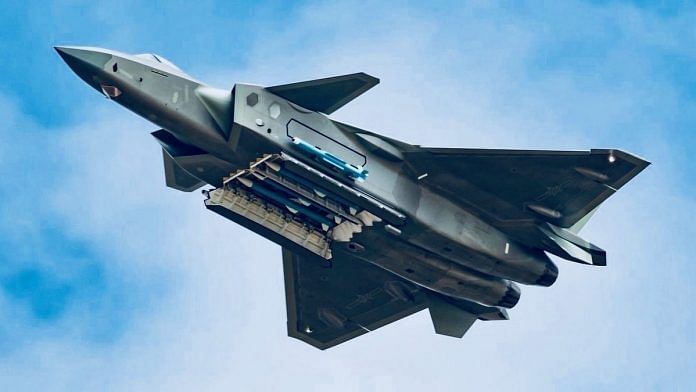
In recent years, China’s technological strides and development of a wide range of air-to-air missiles (AAM) has prompted some nations to integrate these missiles on their fighter fleet, or simply go in for collaboration/purchase of a Chinese combat aircraft like the Chengdu JF-17 Thunder. The JF-17, developed in partnership with Pakistan, has been exported to Myanmar and Nigeria and promises to equip a host of third world countries with an affordable option towards beyond visual range (BVR) needs for domination of the skies.
The Chinese are also aggressively marketing their now highly mature fourth generation platform — the Chengdu J-10C Vigorous Dragon equipped with an active electronically scanned array (AESA) radar developed by No. 14 Institute and a potent suite of AAMs — for the export market, including the LETRI PiLi-15 or the PL-15, the most advanced long-range BVR AAM in service with People’s Liberation Army Air Force (PLAAF).
Meanwhile, the world is taking note of these fast-paced developments towards China’s quest to develop next generation AAMs, which beyond the massive scaling up of PLAAF’s ability to hold its own in contested airspace will also affect the market share of other nations in the AAM export arena in the coming years.
lso read: ‘Drone swarms’ are coming, and they are the future of wars in the air
The pace of development of AAMs in China has been nothing short of remarkable, with the focussed and near clinical might of the powerful Chinese state thrown behind this key capability, specifically being developed to counter the global expeditionary deployment and air domination of the United States Air Force (USAF) and the United States Navy (USN).
Interestingly, in the 1990s, China’s AAM inventory consisted of weapons purchased from Russia or direct copies of them and western AAMs like the AIM-9 Sidewinder and Matra Magic.
China also secured a large number of Python 3 AAMs from Israel, which were licensed as the Luoyang PiLi-8 or PL-8. The transformation to an indigenous AAM development pipeline took place with induction of the Russian Su-27 Flanker platform, wherein the Chinese closely took a look at the advances made by the Russians in this domain and blatantly reverse engineered Russian AAMs.
Access to a host of technologies and scientists working in the field of AAMs after the collapse of the Soviet Union also helped China’s cause.
The Leihua Electronic Research Institute (LETRI) and the No. 607 institute’s PiLi 12/PL-12 BVR active homing AAM was the first potential success story for the Chinese home industry, development for which was started in the 1990s.
Based on the Russian R-77, the PL-12 was developed specifically to counter the US AIM-120 AMRAAM. The miniaturised AMR-1 active seeker, a copy of the Russian 9B-1348 seeker on the R-77, was developed with help from AGAT Research Institute in Moscow.
With development of follow-up versions, improved ECCM is now available. The overall performance of the PL-12 possibly rivals the R-77 (RVV-AE) and AIM-120 C-4.
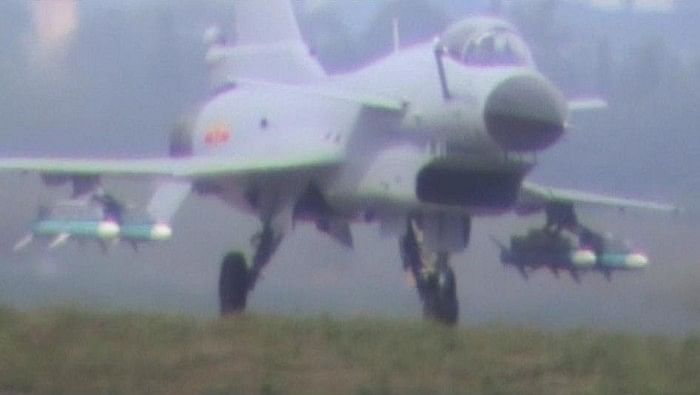 A J-10A armed with PL-12 AAMs. | Photo: sameerjoshi73.medium.com
A J-10A armed with PL-12 AAMs. | Photo: sameerjoshi73.medium.comSignificantly, the PL-12A/B/C (the C version having foldable tail fins) allowed the Chinese industry to understand the nuances of this high technology domain very well, primarily how a modern AAM development looked like; spawning a wide range of in-house R&D while gradually reducing their reliance on external support from Russia.
Ramjet propulsion has been believed to be tested on the PL-12D variant. The PL-12 AAM has been exported under the designation SD-10A with the JF-17 platform. The SD-10B promises a far greater NEZ, better anti-jam capability and possible passive homing ability against Airborne Early Warning & Control (AEW&C) aircraft. The maximum range of the PL-12 varies between 60 and 90 km.
Also read: Aero India 2021 — world’s first ‘hybrid’ air show takes flight in Bengaluru this week
China’s roadmap of development expanded beyond the PL-12 with the Luoyang PiLi-10/ PL-10, an advanced dogfight weapon developed to counter western missiles like the AIM-132 ASRAAM, IRIS-T, A-Darter and the AIM-9X.
Development began at the Luoyang Electro-Optical Centre around 2004-05. The PL-10 features a multi-element imaging infrared (IIR) seeker, laser proximity fuse, a thrust vectoring motor, with an off bore-sight capability of 90 degrees. It has a lock on after launch (LOAL) capability, which gives it beyond the within visual range engagement capability, much like the MBDA ASRAAM and the South African A-Darter.
It is believed to have entered initial production in 2013 equipping all fighter types in the PLAAF, as well as export JF-17 sales. This missile will be effective out to 30-40 km and in terms of performance, may rival similar within visual range (WVR) designs across the world.
The LETRI PiLi-15/PL-15 is the most advanced AAM deployed by the PLAAF in recent years. An evolution of the PL-12, the PL-15 has been redesigned with a cropped main and tail control fins with a smaller wingspan to fit into the internal weapon bay of the next generation J-20 and the J-31 fighters.
It is powered by a dual pulse rocket motor, giving it an estimated range of 200 km with a large NEZ. It is equipped with a two-way datalink for dynamic re-targetting in air. The active seeker uses an AESA aperture developed by No. 607 institute, which has a narrow target acquisition beam. The AESA seeker also gives robust ECCM capability. The missile was tested in 2015 and now equips the J-10C and the J-16s, as well as the limited number of J-20s in service.
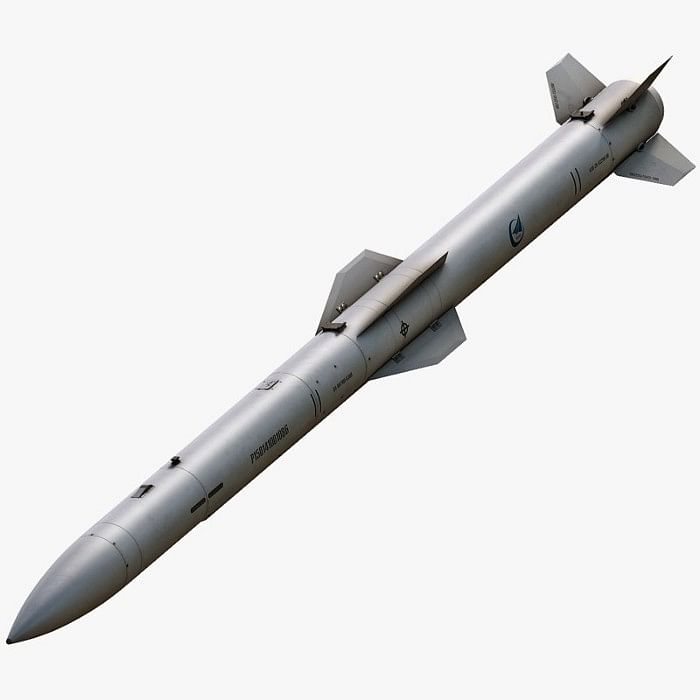
Incidentally, all carrier types are equipped with an AESA airborne interception (AI) radar, which gives them ability to launch the missile in LOAL mode and guide the PL-15 through the datalink in an active or a passive mid course guidance routine from the same/different platform till such time the AAM goes active (A-Pole). This works well for slashing and stealthy attacks by these fighters, especially the J-20 with its low observable (LO) features.
It is also believed that mid course target update may also be available vide special mission aircraft like the KJ-2000/500/200 AEW&C, much similar to the passive guidance available on the AIM-120D AMRAAM.
Like the US, China has realised the challenges of squeezing more missiles into the weapons bay of the LO fighter, with four PL-15s fitting into the bay of the J-20. However, the Chinese may be working on a further compressed version of the PL-15 (PL-16?), with a performance similar to the PL-15. This will ensure that more long-range AAMs can be carried inside the conformal weapons bay of the J-20.
Nonetheless, the PL-15 is the weapon of concern for the rest of the world, having an ability to match up to the long-range engagement envelope of the MBDA Meteor and the Russian R-37M. It possibly outranges the USAF’s latest version of the AMRAAM, the AIM-120D; precisely the reason why Lockheed Martin has been urgently tasked to develop the AIM-260 and restore the balance back in favour of the United States Air Force.
And then there is the very long-range PL-XX (possibly PL-17?) AAM. First seen on a PLAAF J-16 in late 2016, this massively lengthy missile has been dubbed the ‘flying telegraph poles’ in the West. The PL-XX is most surely meant to engage and hold at risk assets like AEW&C aircraft and air refuelling tankers out to 300+ km. It most probably has a large dual pulse rocket motor and equipped with an AESA terminal homing radar seeker.
Some reports also indicate a secondary imaging infrared seeker, which will help increase the kill probability (PK). The VLRAAM is expected to fly a ballistic trajectory in the stratosphere to achieve its long range much like the erstwhile AIM-54 Phoenix. Presently the PL-XX has no match in the West, though the R-37M has a similar high trajectory interception profile. The first successful test flight of the missile was carried out in 2016 and as of now, it is mated only with the Shenyang J-16 fighter.
China is also exploring ramjet technology, experimenting with variants on the PL-12 and other types to develop a missile like the MBDA Meteor. While it is a matter of time before such technology is available to the Chinese, the ongoing production focus is on dual pulse, large form factor, solid fuel rocket motors to increase the range, as well as the no escape zone (NEZ).
Newer captive technology is also being acquired from Russia like the R-77–1 (RVV-SD) with a range of over 100 km, which is the primary armament on the newly acquired Su-35 fighters of PLAAF.
This weapon, especially its active seeker and datalink, will be studied for its worth and benefit the future versions of the PL-12/15s. Ironically, the Chinese achievements in development of AESA seeker for its AAMs, has outpaced similar efforts in Russia.
In fact, the newer generation of Chinese AAMs, especially the PL-15, may be half a generation ahead of the Russian AAM development effort. If one takes a look at what the Chinese have invested into their AAM development in terms of raw capital and weighs it against the Russian equivalent, there is simply no comparison. But are the Russians really behind in the air-to-air missile arms race?
Also read: Why Modi govt will be spending less on defence pensions next year
Russia’s AAM industry has been steadily bouncing back in the past decade. It was severely restricted by very limited internal investment post the collapse of the Soviet Union. Only the exports kept the missile complexes going.
The Vympel R-77 (RVV-AE) NATO designation AA-12 Adder and the Russian equivalent of the AIM-120 AMRAAM, entered Russian Air Force (RuAF) service only around 2015 when it was available for export in the end 1990s. The RuAF has now widely deployed the advanced variant of the missile, the R-77–1 (RVV-SD) on its Sukhoi fleet. This has an engagement range of 100+ km with a redesigned active radar AGAT seeker and new fins. Russian Su-35s have routinely been seen with this type during practice intercepts of NATO assets in the Baltic zone, over the Black Sea and Syria.

The R-77 also has a testbed ramjet version designated the R-77-PD. A more advanced version designated the R-77M or izdeliye 180, is being developed for Russia’s Sukhoi Su-57 Felon low observable fifth generation fighter and the existing Su-35S Flanker-M. The missile features an under development AESA active seeker head and has a large solid state, dual pulse motor with conventional fins. A ramjet version of the same designated K-77ME is also under development.
The K-77M is intended to match up to the AIM-120D and the PL-15, while the K-77ME is meant to take on the ramjet approach demonstrated on the MBDA Meteor. The targeted range of the R-77M will be between 130 and 150 km.
For targets beyond 200 km, the RuAF has inducted the R-37M (NATO designation AA-13 Axehead). The missile and its variants also have the names K-37, izdeliye 610 and RVV-BD. The R-37M is an updated version of the R-37 AAM, which was meant to be the primary armament of the MiG-31 Foxhound against stand-off targets like tanker and AWACS aircraft.
Testing of the R-37 continued through the 1990s. In 1994, a trial round scored a kill at a range of 162 nautical miles (300 km). However, the programme appears to have been dropped around 1998 over cost.
Work on the missile was restarted in late 2006 as part of the MiG-31BM programme to update the Foxhound with a new radar and LR air engagement capability. In 2018, the R-37M finished its operational validation tests. It flies at hypersonic (Mach 5+) speeds and has a range exceeding 300 km. The range depends on the flight profile, from 150 km for a direct shot, to 400 km for a cruise glide profile in the stratosphere.
It may well also be carried by the Su-35 and the Su-57. The missile can be guided semi-actively or actively through AGAT 9B-1388 active seeker. The R-37M is said to have the ability to engage supersonic cruise missile carrying bombers like the B-1 Lancer as well as the cruise missile projectiles. The weapon deployed on the MiG-31BM, offers a very unique long-range interception capability to the RuAF, unbeaten by any air force in the world at present. A likely upgrade with an AESA seeker may happen in the near future.
Russia is also grappling with a need to replace its R-73/4 (NATO codename AA-11 Archer) WVR AAM for some time. Although a game changer when introduced in the 1990s with its massive off-bore sight lock on capability, the lack of an imaging infrared (IIR) seeker makes it very vulnerable to modern countermeasures.
An improved version of the R-74, the K-74M izdeliye 750 has been developed, which features fully digital and re-programmable systems and an IIR seeker, intended for use on the Mig-35/29 and the Su-30/34/35 family. A further upgrade, known as the K-74M2 izdeliye 760, is intended for the Su-57 aircraft. This missile has reduced cross section to fit in internal weapon bays and will match the performance of the AIM-9X, ASRAAM and the PL-10. The K-74M has an effective range of 35km.
A recent snap at the Vympel factory shows the presence of another AAM, which is distinctively shorter than the R-74. While no information is available on this type, it is believed to be a WVR development for the Su-57 platform and may be carried in the internal weapons bay. It is indicated by the red arrow in the photo below.
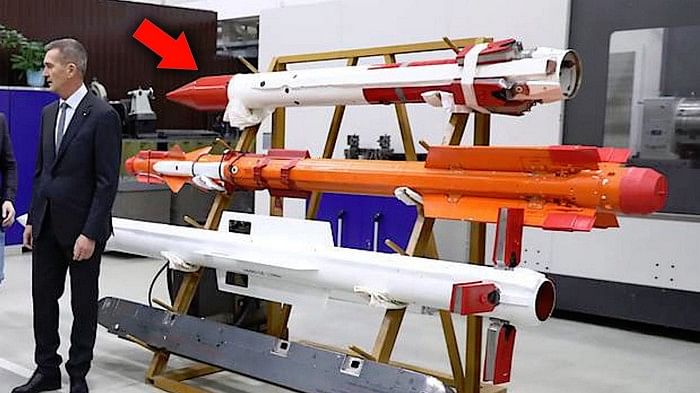
What is noteworthy is the rapid spike in China’s AAM development ability, which has unnerved the Russians to a great extent. Investments in Russian programmes in the last decade have partially been spurred by China’s ability to fast track this vertical. Concerns that China will undercut the Russian AAM export market share have proven to be correct.
China is positioning its military hardware with its economic Belt and Road Initiative (BRI), tactically pushing its military hardware on third world nations at a cost effective price point. A prime example of this effort is Myanmar, which has received Russian military aid in the past. While Russia does not have an economic might to put behind defence development initiatives the way China does, a resurgent nationalistic agenda in Moscow is helping the revival of next generation aerospace and defence programmes to an extent.
It is here that the Sukhoi Su-57 development and upgrades to the MiG-31 and Su-35 fleet, will drive induction of more competitive AAMs in the near future geared to counter the NATO alliance. These will also more often than not, find their way to the export market dovetailed with the sale of Russian fighter aircraft.
The Russians, however, seem to very well realise that unless they promptly scale up research in next generation AAM technologies, the capability gap between the West as well as China, will only keep widening — especially on the bang for the buck scale. That would crucially hit Russia’s profitable defence export market share.
Also read: Defence capital budget sees 19% jump, Finance Commission calls for non-lapsable fund
The deadliest air-to-air missile in the world is the MBDA Meteor, which got operational in 2016 on the SAAB Gripen fighter fleet and now also equips the Eurofighter Typhoon and the Dassault Rafale.
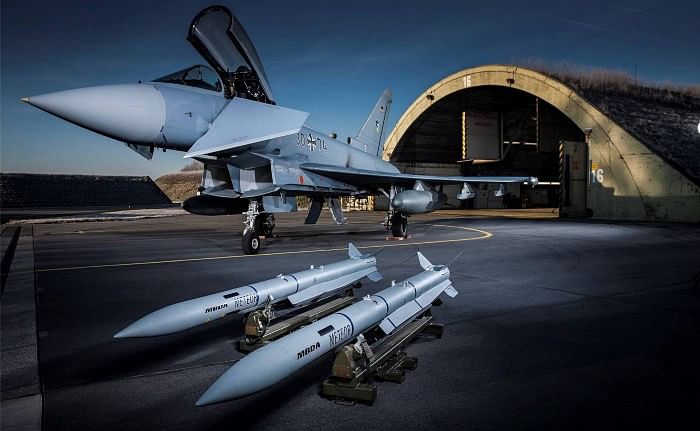
The Meteor possibly outranges all missiles in the world while engaging manoeuvring targets at long-range. A core capability on the Meteor is the world’s first operationalised ramjet motor. At launch, the Meteor is boosted to a speed above Mach 2 by a conventional motor, propelled by fuel from a chamber, which eventually becomes the ramjet combustion chamber when the rocket fuel expends. Above Mach 2, the missile transitions to ramjet operations, maintaining a ‘throttle able’ speed up to Mach 5.
This massively boosts the range and the Meteor’s PK — achieved through a very large No Escape Zone (NEZ) — till within which the target cannot kinematically outrun the missile.
The AIM-120D and the PL-15 have a NEZ much smaller than the Meteor since the Meteor with its throttle capable engine can vary and use optimal fuel during cruise, and accelerate toward the target during the terminal phase of the engagement (endgame) with a far higher potential energy state.
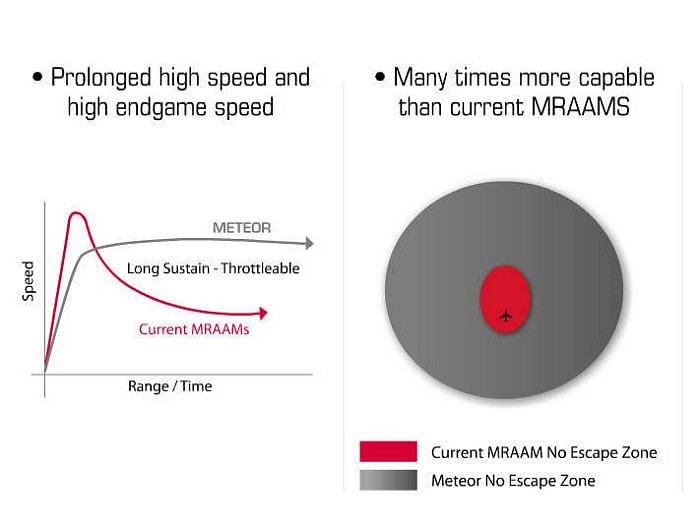
In contrast, while the AMRAAM has a dual impulse engine, once the boost phase is over and the missile coasts, it will fly unpowered for a larger portion of the NEZ. The Meteor with its Ramjet propulsion, sidesteps the second way to boost range as in the PL-15, PL/XX and the R-37M, which carry more propellant. This leads to bigger and heavier missile systems, limiting the number of fighters types which may be able to carry them.
The Meteor thus is a weapon of choice for the current crop of fighters in European service. What the Meteor has done is to make sure that European Air Forces have a weapon that maintains long-range superiority over the Chinese PL-15 and the Russian R-77–1 in a way that the US AIM-120 cannot.
So while ramjets are a way forward for the AAMs to extend their engagement range and envelope, it comes with a cost intensive premium tag and may not be the first choice for all end users, including the United States.
The AIM-120 AMRAAM is the West’s most proliferated air-to-air missile and the US has concentrated on miniaturisation of technology rather than increasing the size of the AIM-120 through its life cycle to expand its range, engagement envelope and PK over the past few decades.
It has largely succeeded and the present top of the line iteration, the AIM-120D is propelled by a dual pulse solid fuel motor, a superbly jam resistant RF seeker and a bidirectional data link, achieving a range which is classified, but may be to the tune of 150-180 km. This has been achieved maintaining reliability within the original form factor, albeit with minor changes to control surfaces over the previous iterations. The AIM-120D equips USAF’s premier fighters like the F-22, F-35, F-15 and the F-16s, giving them a measure of long-range air domination across a variety of missions.
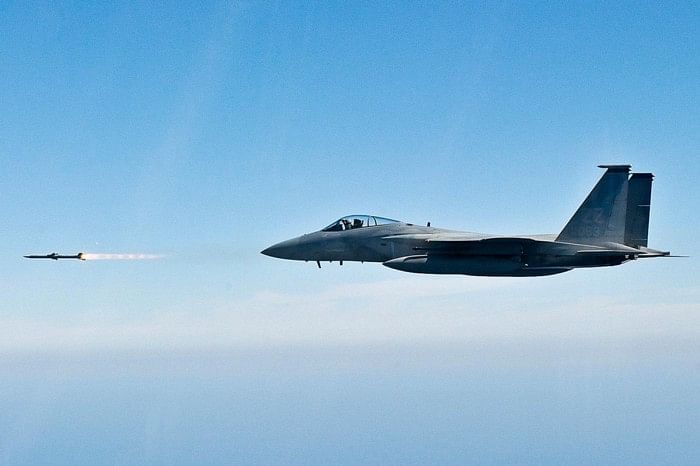
However, the arrival of the Chinese PL-15 AAM in 2016, has changed the dynamics of air supremacy as perceived by the USAF.
For the first time, the US faces a near peer state competitor, capable of engaging its air assets at ranges equal to or greater than the engagement capability of the USAF missiles, effectively outranging them. The PL-15 mated with a LO platform like the J-20, as well as the incoming Russian Su-57 armed with a R-77M/ME, could well erode away the supremacy enjoyed by US fifth generation fighters like the F-22 and the F-35.
In addition, the AIM-120 is fast reaching a stalemate in the miniaturisation effort to performance achieved matrix. Further reduction in size of internal components may not be able to give any worthwhile increase in long-range performance even with the use of newer grades of chemical propellants.
Interestingly, while research is taking place in the development of newer propellant mixes to increase the pulse peak power, nothing seems to be available for porting onto the AIM-120 family. In addition, measures to clean up the existing aerodynamic form factor will only yield minor results in the existing design. The USAF realises that it needs a newer and more potent BVR AAM for carriage in the internal weapons bays of its premier LO fighter fleet.
Towards this, the US Air Force and the Navy have been quietly working together to develop a new AAM called the AIM-260 that will replace AIM-120 AMRAAM.
The AIM-260 programme, also known as the Joint Air Tactical Missile (JATM), has been going on since 2017, but was publicly discussed for the first time in 2019. JATM has hired Lockheed Martin to develop a new AAM.
According to USAF, the AIM-260 will maintain the form factor of the AIM-120 and not use a ramjet motor like the Meteor. At the same time the missile will outclass the competition from the PL-15 and expected versions of the R-77 in Russia. It is possible that advances in rocket motor and warhead technology may be enough to provide a considerable boost in range when combined with a new, streamlined body.
It may have a set of miniaturised electronics and a warhead that offers improved lethality in a smaller package to create space for additional rocket fuel. The AIM-260 may employ a mixed propellent, as is envisaged for France’s Mica NG missile, which intends to use a dual pulse motor developed by Roxel that provides the weapon with up to 30 per cent more range. The pulse will also provide more power when dealing with engagement of highly manoeuvrable targets. The new version of Mica is set to debut in 2026.
The AIM 260 may employ a technologically advanced philosophy of the Israeli I-Derby ER (Extended Range) AAM. The upgraded I-Derby missile is equipped with a software-defined active radar seeker, which activates the warhead, doing away with any manner of proximity fuse. This creates additional space for the rocket propellent, which boosts the range.
Further, an AESA based RF seeker with its low energy requirements and good counter measures, will help reduce the size and shape of core electronics further, extending the target acquisition and lock on envelope.
Japan’s AAM-4B missile has an AESA seeker, which can switch to its own active guidance (A-Pole) at 40 per cent greater range than the AIM-120. This allows the fighter updating the missile towards mid course guidance to ‘snip’ at a further stand-off range, thus allowing the fighter far greater flexibility in the engagement zone.
AESA is also the way forward for the RF guidance Mica NG discussed above. Hence, while the AIM-260 is still three-five years away from active service, there are enough indicators to what technologies the missile is likely to utilise.
It is also worth noting that the AIM-260 appears to be just one part of a future family of advanced air-to-air weapons.
The JATM programme is separate from the Long Range Engagement Weapon (LREW) project. This programme has worked as an exploratory initiative used to identify the overall concept, technologies, kill chain structure, and baseline requirements for a new long-range AAM or family of missiles.
Such a weapon could well leverage a new family of small, hit-to-kill, intermediate to short-range air-to-air missiles as primary payload attached to a booster. This would maximize weight for propellant and the payload. The weapon could also be used without a booster for far shorter range engagements. A part of them would also be utilised as defensive hard kill missiles, which could react along with defensive suites like chaff and flares.
Progressive and meaningful upgrades have also kept the West’s shorter range weapons relevant. The AIM-9X Sidewinder is the top dog NATO missile with thrust vectoring flight controls, a strengthened airframe to cope for extreme maneuvering and a high resolution IIR staring focal plane array seeker in the nose.
Raytheon has also added a smarter fuse and datalink to the AAM for LOAL options, much like the Python -5, MBDA ASRAAM and IRIS-T, which share similar technologies.
The Chinese PL-10 and the Russian K-74 also come close in matching up to these western IIR AAMs. Hence, engagements in the WVR bubble would always pose problems for the engaging assets with equivalent technologies where ECM and ECCM measures would play a dominant role in aircraft survivability.
While the existing European fourth generation platforms will continue to harness the potential of missiles like the Meteor and the planned Mica NG for long-range engagements while increasing their carriage options, for the USAF, it will be low observable aircraft which will drive the next genre of AAMs developments.
These platforms may be able to approach their targets using stealth, but will be restricted by the few weapons they carry in their internal weapons bay (6 x AIM-120, 2 x AIM-9 for F-22 and 4 x AIM-120 for the F-35) to shoot down threats in contested airspace. And this is where small form factor, yet missiles with a high PK are likely to proliferate.
Raytheon has proposed the 1.8m long Peregrine AAM with a multi-mode autonomous seeker, with the range of the AIM-120D and the manoeuvrability of the AIM-9X. Lockheed Martin has also unveiled its CUDA hit to kill weapons technology.
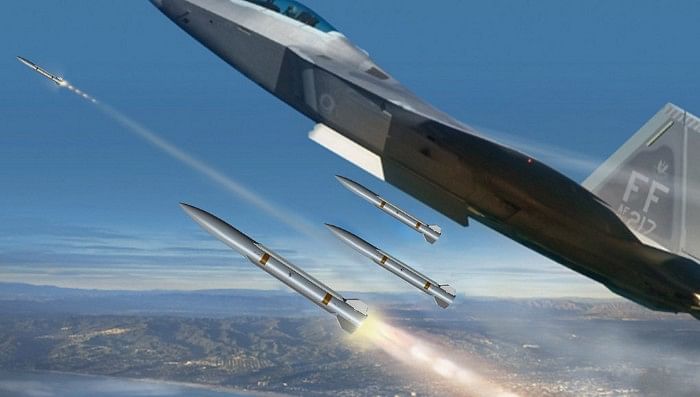
Simply put, smaller missiles with advanced capabilities may be the next major step in evolution of future AAMs for the USAF, which having spent so much on stealth aircraft, would certainly like to boost their cost effectiveness per kill.
Also read: B-1B Lancer, the long-range US bomber with 50 world records that will ‘fly-by’ at Aero India
The only worthwhile effort in the BVR missiles domain outside the US, Europe, Russia, Israel and China is taking place in Japan and India.
In 1999, the Japanese unveiled the Mitsubishi AAM-4 Type 99 air-to-air missile, 99 Shiki Kūtaikū Yūdōdan, which is a medium range active radar homing BVR developed in Japan, to replace the AIM-7 Sparrow for service on the F-15J and F-2.
The remarkably improved AAM-4B, which entered production in 2010, was the world’s first AAM with an AESA radar. The AAM-4B is however large to be carried in the weapons bay of the newly inducted F-35 Lightning II. Hence, in 2014 Japan announced collaboration with the United Kingdom to study the development and integration of a new Joint New Air-to-Air Missile (JNAAM) for service on JSDAF F-35s. MBDA UK is the prime contractor on the slightly modified Meteor missile, which can fit in the internal weapons bay of the F-35.
The JNAAM will combine the UK’s missile-related technologies and Japanese AESA seeker technologies, possibly with some adjustments to help the missile fit better in the F-35 weapons bay.
JNAAM will address the threat posed to Japan by the Chinese PL-15 and Pl-XX. By amalgamating the long-range, large NEZ USP of the Meteor with the highly advanced Japanese AESA seeker with greater detection ranges than the AIM-120D, the Japanese will have a very unique and deadly missile in their arsenal.
The Defence Research and Development Organisation (DRDO) in India has indigenously developed the Astra, an all-weather medium range AAM. Astra is equipped with a locally developed RF active seeker with a good anti-jam capability for terminal homing. It has a dual pulse rocket solid motor, which offers decent potential during endgame manoeuvres.
A dual axis datalink connects the missile to the carrier aircraft during mid course guidance and terminal targeting phase. It is capable of engaging targets at varying range and altitudes, allowing for engagement of both short-range targets at a distance of 10 km and long-range targets up to a distance of 110 km.
Astra has been integrated with the Indian Air Force Su-30MKI and the HAL Tejas fighters. Limited series production of Astra missiles began in 2017. In terms of capability, the Astra Mark 1 is equivalent to the AIM-120 C-7 and the R-77–1 AAMs.
After the development of Astra Mark 1, three new variants are planned for future — Astra IR close combat missile with IIR for shorter range up to 40 km; Astra Mark 2 with larger engagement envelope and a range of 160 km equivalent to AIM-120D (towards this, propulsion systems under consideration includes liquid-fuel ramjet, solid-fuel ramjet and a larger dual pulse solid motor); and the Astra Mark 3 with solid fuel ducted ramjet is planned to have a range in excess of 200 km.
Also read: Army to get Belgian Malinois, dog breed that helped in Osama raid, chased ISIS chief
Interesting trends emerge after reviewing the AAM development philosophies across the world.
— There is a clear race to dominate and engage the adversary at the longest possible range in the battle space. This involves development of missiles which can reach afar faster and have a large NEZ, resulting in a greater kill probability.
— Russia & China have developed large sized AAMs, with oversized rocket motors and large propellent carriage. They have the complimentary fighters for carriage of large stores in greater numbers.
— The Europeans have bet big on the Ramjet route to increase engagement envelope and PK at long ranges. In addition, mixed propellents are being experimented with, which provide a bump up in the maximum range.
— Ramjet propulsion is a challenge for most nations due to investments in cost and technology. However, Russia and China will achieve parity in this field by early 2020s. This will filter down to all class of AAMs in their inventory, adding increased PK at longer ranges within layered Anti Access/Area Denial (A2/AD) zones.
— The current crop of Chinese and Russian AAMs are a cause for major worry for NATO and especially for the United States, with the PL-15 possibly outranging the AMRAAM.
— The United States fifth generation LO fleet made up of the F-22 and F-35 is overshadowing the development of small form factor missiles, which will be exceed the existing performance capability of the AIM-120D. The number of missiles carried in internal weapons bay, will increase. This will convert into larger engagement cycles per sortie. The Chinese J-20 and the Russian Su-57 are adopting a similar strategy.
— In addition, shorter range, very high PK missiles are concurrently being developed. These will aid in engaging targets at closer ranges, when taking advantage of stealth.
— Miniaturisation of electronics and adoption of lightweight AESA active seekers will be preferred.
— There is enough room for proliferation of WVR missiles, which dominate engagements at shorter ranges with effective IIR technologies.
— Rapid stride of an order of magnitude in ECM and ECCM techniques will take place, especially within the NEZ.
— Engagement of stand-off assets like AWACS, AAR etc will be possible at VLR of 300+ km.
— The longer reach of AAMs will force the contemporary attack platforms to invest in air to surface payloads, which will now need to be launched even further away from the target zone.
— An air force equipped with medium range AAMs and low NEZ, will be at a disadvantage in offensive/defensive missions in any future air war. The combination of low signature fighters, mated to high kill probability AAMs will be a normal in 2030s.
— Loyal wingman platforms (highly intelligent UCAVs) and optionally manned fighters, as well as their teaming with manned assets is being tested worldwide. Their employment will spur the next iteration of the AAM development cold war in the years ahead.
Also read: ‘For just a bloody cannon’: How a MiG-21 nearly took down a PAF Sabre on debut for IAF in 1965
So how good the Chinese air-to-air missiles really are? While little open source details are available about the flight testing aspects and operational use of Chinese AAMs, experts believe it would be premature to dismiss indicative capabilities in light of the achievements in the field of science and technology by China in the last few decades.
Here the PL-15 AAM development has been a game changer, which leapfrogs the Chinese ability to engage in offensive operations in a contested environment.
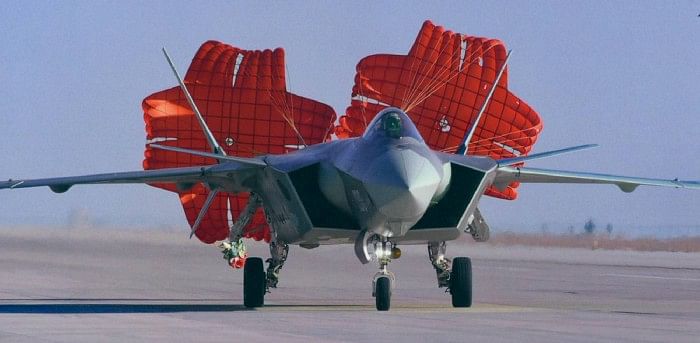
Whereas the Chinese air-to-air missile capability may not be at par with sophisticated western missiles like the MBDA Meteor, there is more than enough technological evidence that China, along with Russia, is fast closing the AAM capability gap with the West, with the western nations no longer in a position to take air dominance missions for granted.
Sameer Joshi is a retired Indian Air Force fighter pilot with experience on the MiG-21 and Mirage-2000 jets. Besides being a start-up entrepreneur, he has serious interests in aerospace & defence and military history.
He has referred extensively to, and would like to acknowledge, the superb source material and work done on the subject by Andreas Rupprecht, Warzone, Janes Defence Weekly, Airpower Australia and Tony Osborne in the Aviation Week.
Also read: 1965 Sargodha attack: How IAF hit Pakistan’s most protected base & destroyed 10 aircraft
The farmers’ protests have attracted the Opposition, whereas several political parties refrained from supporting the anti-CAA protests, barring the Left and a few others. They were even muted in their criticism of the govt’s handling of communal riots in north-east Delhi. The Supreme Court was willing to suspend the farm laws, while it declined to stay the CAA in 2019.

Up in arms: The government’s response makes it clear that it is not willing to tolerate protests. PTI
The past one year has witnessed major protests which are signposts of a country in ferment. The winter of 2019-20 saw protests, rallies and sit-ins against the discriminatory Citizenship Amendment Act (CAA) across India, the most famous of them led by the women of Shaheen Bagh in south Delhi.
In the winter of 2020-21, India is amid a massive sit-in on Delhi’s borders led by farmers protesting the contentious farm laws that they see as a threat to their livelihood. Both protests have made it clear that mass movements are the most effective way of standing up to an authoritarian regime.
These agitations are watershed moments in the history of public protests in modern India. Both the anti-CAA stir and the agitation by farmers were resolute, dignified and peaceful. Although the farmers’ protest had largely been peaceful, it took a violent turn on January 26 when a group of protesters clashed with the police within the precincts of the Red Fort. Both protests are reminiscent of ‘Occupy protests’ that have emerged over the past decade in other parts of the world.
Both protests happened in public spaces, for example, on major highways, calling attention to their opposition to the new laws. They have created a new grammar of protest and called for resistance outside institutional spaces by invoking a ‘citizen activist’ strand. Both protests have defined their grievances by identifying how the respective laws undermine broader economic and political rights. These protests challenged authoritarianism and majoritarianism by demonstrating in their everyday practices a commitment to democratic methods and inclusive politics. Most occupy protests remain confined to the distinctive spaces where they emerge, but these protests have inspired similar ones across the country. They defied the odds in their refusal to disband despite huge pressure to do so and the government’s refusal to concede their demands. The very act of patiently waiting through prolonged sit-ins in biting cold offers a sharp contrast to the state’s paranoid, confrontational, and aggressive stance.
However, politicians, public institutions, courts and the police system have treated them very differently. The differences in response to the two protests are instructive in itself and worth noting. Within days of the farm protests, the government began negotiations. It has offered to temporarily suspend the legislations which were reiterated by the Prime Minister recently, even though it failed to break the impasse. Nothing like this happened during the anti-CAA protests. Farm laws can be reviewed, but the CAA cannot be reviewed. For the Hindu Right, CAA is part of a longer battle to redefine secular India as a Hindu nation. For them, Muslims exist in a state of exception, where they cannot take their rights for granted or protest when these rights are denied to them.
The farmers’ protests have attracted the support of most of the Opposition, whereas several of these political parties refrained from supporting the anti-CAA protests, barring the Left and a few other parties. They were even muted in their criticism of the government’s handling of communal riots in northeast Delhi and the targeting of Muslims and civil society activists, many of whom are still under detention.
While the activists and protesters, in both cases, believed in the potentially progressive power of the courts, the courts regarded them differently. The Supreme Court was willing to suspend the agricultural laws and appoint a committee, although packed with pro-farm law voices, to examine the issue, while it declined to stay the implementation of the CAA in December 2019 and did not suggest expert arbitration.
While hearing a batch of petitions against the anti-CAA protesters for allegedly causing inconvenience to the general public with a road blockade, the top court ruled that the right to protest in public places is not absolute, and public places cannot be occupied indefinitely. The court said that while dissent and democracy go hand in hand, protests must be carried out in designated areas. In the case of the tractor parade, the court left it to the Delhi Police to decide whether it should be allowed to enter the Capital on Republic Day.
The government’s response to the two agitations makes it clear that it is not willing to tolerate protests; in fact, it is determined to de-legitimise and criminalise them. This was most visible in the wake of the anti-CAA protests. A similar treatment is being meted out to the protesting farmers. It has followed a standard playbook which involves demonising and attacking protesters — in the case of the farmers, they are being discredited with labels such as Khalistanis and terrorists. But this did not gain the same traction as the ‘othering’ of Muslims during the anti-CAA protests. Given the failure to vilify the protesting farmers in the name of nation or religion, it has found it difficult to contain their protests.
Bhartiya Kisan Union leader Rakesh Tikait’s defiance appears to have energised farmers in western Uttar Pradesh and Haryana and this could have wider political implications in the coming months. To counter it, the government is making every effort to convert the January 26 violence into an opportunity for greater repression — threatening arrests, stifling dissenting voices and blocking Internet services and Twitter handles of those critical of state excesses. The Delhi Police putting up fences, welding iron rods into flyovers and embedding big nails on streets to prevent farmers from assembling, is unprecedented. No government has gone this far to stop protests. The ridiculous response to global pop star Rihanna’s six-word tweet and the full-scale kerfuffle over it shows how rattled the government is by the increasing support for these protests.
The official response to these two protests underlines the government’s determination to continue on the authoritarian path. Although these very similar occupy-type protests have evoked very different responses, the regime’s ultimate strong-arm tactics in both cases show how an authoritarian (and majoritarian) government is incapable of resolving crises or tolerating any criticism or dissent. Both sit-ins remain a testimony to the power of public protest and the possibility of facilitating political change. Regardless of the outcome of farmers’ protests and the government’s refusal to retract the CAA, if the government continues to demonise and attack all protesters, it will only lose.
Deepender Deswal
Tribune News Service
Hisar, February 7
Farmer leaders Rakesh Tikait, Balbir Singh Rajewal and Darshan Pal Singh were among the thousands of farmers gathered at a mahapanchayat in Haryana’s Charkhi Dadri on Sunday to garner support for the protest against the three contentious farm laws.
Farmer leader Darshan Pal Singh gave a call to intensify the agitation in Haryana.Farmers attend the ‘mahapanchayat’ in Charkhi Dadri, Haryana, on Sunday. Tribune Photo
“The Haryana BJP government has let down people and has no right to stay in power,” he said.
He said he had cautioned the government about the new Bills during the initial discussion but his voice was not heard.
Also read: Farmer unions write to India head of UNHRC, seek intervention in farmers’ arrest
No ‘ghar wapsi’ till farmers’ demands are met: Tikait
Taking a lesson from the Jind ‘mahapanchayat’, organisers of the ‘mahapanchayat’ at Kitlana have set up a brick-lined stage and enclosed it with pipes to ensure the safety of the farmer leaders at the stage.
Singh urged the youth to come ahead and take forward the agitation.
“We have debated clause-wise on the law but lies have been spread about the discussion. Union Ministers have realised their mistake in the enactment of laws. Sarv khap panchayat has immense strength to take the stir ahead and we hope that a united struggle will ensure win of the farmers,” Singh reiterated.
Haryana Deputy Chief Minister had stated that he would resign from the government if issue not resolved by January 26.
Rakesh Tikait said khap panchayats had emerged as a strong social set up during the times of Raja Harshvardhan.
“The government tried to divide people on the basis of Haryana and Punjab, Sikh and non-Sikh but you should stay strong. There is not a single weak link in the agitation,” he assured the kisan morcha leaders.
On the violence of Republic Day, he alleged: “Our young people were misguided and taken to the Red Fort by government agencies.”
“Two government representatives came to meet me yesterday but I refused to meet them separately as every discussion will be held collectively in the presence of 40 members of the kisan morcha,” Tikait said.
The MLA from Charkhi Dadri and Sangwan khap pradhan, Sombir Sangwan, on Saturday had said the ‘mahapanchayat’ would be a ‘turning point’ in the agitation of the farmers against the farm laws.

Farmers protesting against the three farm laws listen to a leader at the Tikri border on Sunday. PTI
Tribune News Service
Sonepat, February 7
Three more farmers died at the Tikri border on Sunday during the ongoing farmers’ protest against the three farm laws. A farmer from Singwal village in Jind district reportedly hanged himself.
Heart attack was suspected to be the reason behind the death of two farmers from Punjab.
Karambir (52) of Singwal village in Jind district reportedly ended his life by hanging himself from a tree near the Sector 9 bypass. He was a part of the protest since the last week of November.
One of them was BKU leader
- Karambir (52) of Jind’s Singwal village reportedly ended his life by hanging himself from a tree
- In the suicide note, he blamed the three farm laws and the Cente for taking the extreme step
- BKU leader Sukhjinder Singh (57) of Moga district and Lakha Singh of Sangrur district died of heart attack
Fellow farmers said they played cards till 11 pm last night, after which they went to bed. They said they found his body hanging from a tree in a park this morning.
The police reached the spot after getting information. The police recovered a suicide note from a pocket of the deceased, in which he blamed the three agricultural laws and the Centre.
The police handed over the body of the deceased to his kin after postmortem.
A large number of villagers and farmer activists attended his cremation. ‘Kisan ekta zindabad’ slogans reverberated as his body was being taken for cremation. The deceased is survived by his wife and three daughters.
Two farmers from Punjab also died at the Tikri border today. One of them was identified as Sukhjinder Singh (57) of Dhulkot Ransi village in Moga district. He was president of the Nihal Singhwala block of the BKU (Qadian).
He was part of the first group which reached the Tikri border on November 26 and had been putting up in a trolley near pillar number 75.
Another farmer, Lakha Singh of Kalondi village in Sangrur district, died today. He had arrived at the Tikri border on February 3 and had been putting up with a group of farmers near the Sector 9 bypass.
He went for a morning walk today and lay down after coming back. When other farmers called him for tea, he did not respond. They took him to the General Hospital, where doctors declared him dead.
BKU spokesperson Rakesh Tikait during a Mahapanchayat, organised by Bharatiya Kisan Union (BKU) and khap panchayat, to mobilise support for their ongoing agitation against Centre’s farm reform laws, near Kitlana toll in Charkhi Dadri district on Sunday. PTI photo
New Delhi, February 7
The demand for cutouts of Rakesh Tikait at Singhu border underlines the growing popularity of the farmer leader credited with reviving the farmers’ movement against the Centre’s farm laws following violence during a tractor rally on Republic Day.
Roadside stalls selling badges, posters and other literature related to the farmers’ stir are a common sight at Singhu border.
Wasim Ali, who has set up such a stall at the protest site, says hand-held cutouts of Tikait are a big hit among the crowd.
“Each cutout of Tikait is priced at Rs 20. I have been selling the cutouts since the last few days as they are in high demand,” he said.
Around 700-800 such cutouts are sold every day, said Ali, a resident of Bawana in north west Delhi.
“I usually buy these cutouts from Sadar Bazar and sell them here. These are the most demanded items at my stall,” he added.
Tikait’s image received a massive boost after he defiantly announced to continue the agitation, even as a large posse of Uttar Pradesh police personnel gathered at Ghazipur protest site after the Republic Day violence, with rumours rife that he might be arrested.
A section of protesting farmers had entered Delhi and reached up to ITO and Red Fort in the heart of the national capital during their tractor rally on January 26. In clashes between police and farmers, scores were injured and property, including buses, were vandalised.
The Bharatiya Kisan Union (BKU) leader was unwell when a large number of UP police personnel gathered at Ghazipur border where he had been camping for over two months in protest against the contentious farm laws.
A cornered Tikait, however, addressed a huge crowd at the protest site, which has now become a focal point of the agitation, after his teary-eyed speech was beamed by news channels amid dwindled presence at Ghazipur border after the January 26 violent clashes.
He had reaffirmed the resolve of the farmers, saying “they won’t relent or retreat”.
Tikait’s emotional appeal galvanised thousands of farmers from western UP as well as Punjab and Haryana, who took to road to join the agitation that had faced the threat of petering out in the wake of the January 26 episode. PTI
Many of the protesters, driving tractors, reached the Red Fort and entered the monument on Republic Day. Tribune file
New Delhi, February 7
The Delhi Police on Sunday arrested a 60-year-old man from Chandigarh in connection with the violence that took place at Red Fort during the farmers’ tractor parade on Republic Day, officials said.
With his arrest, the total number of people nabbed by Delhi Police in connection with the violence that took place across the national capital on January 26 has gone up to 127.
Sukhdev Singh was arrested from Chandigarh by the Crime Branch team, which is probing 13 cases registered in connection with the Republic Day violence, they said.
The police had earlier announced a cash reward for Singh and three others for allegedly instigating protesters.
The police have also announced cash reward of Rs 1 lakh for information that can lead to the arrest of actor Deep Sidhu, Jugraj Singh, Gurjot Singh and Gurjant Singh who hoisted flags at the Red Fort or were involved in the act.
A senior police officer said Singh was allegedly leading the mob at the Red Fort on the day of incident and he was found to have an “active presence” at the spot.
So far, a total of 127 people have been arrested in connection with the Republic Day violence across the national capital, police said.
Thousands of farmers protesting the Centre’s new agri laws had clashed with the police during the tractor parade on January 26.
Many of the protesters, driving tractors, reached the Red Fort and entered the monument. Some protesters even hoisted religious flags on its domes and a flagstaff at the ramparts, where the national flag is unfurled on Independence Day. PTI
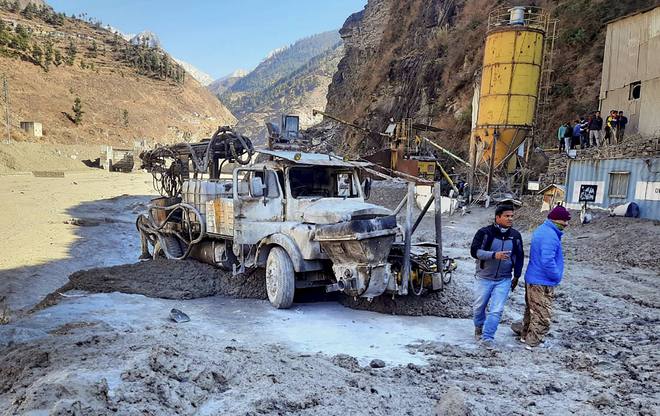
Locals at the damaged Dhauliganga hydropower project site at Raini village. PTI
Raini (U’khand), February 7
It was a tranquil winter morning in Raini village until the residents were jolted at around 10 am on Sunday by a loud sound and the sight of huge torrents of water and sludge in the Rishi Ganga river hurtling towards them.
“Before we could make out what was happening, the raging muddy waters of Rishi Ganga had devastated the landscape,” says Dharam Singh (50), a resident of the village. The scenes brought back to the people horrifying memories of the 2013 Kedarnath deluge that killed thousands.
Many were feared swept away in the sudden floods on Sunday, including those who were working near the river.
Three residents of the village, including a 75-year-old woman identified as Amrita Devi who had gone out to work in her field close to the bridge on the Rishi Ganga, are missing since the avalanche struck after the Nanda Devi glacier burst.
Others missing include Yashpal Singh of Valli Raini, who had gone to the fields to graze his livestock and disappeared along with them.
Ranjit Singh (25) of the village, who worked in the Rishi Ganga hydel project, is also missing after the avalanche.
Pradeep Rana of Juwa Gwan village said Sanjay Singh, a resident of the same village who had gone out to the fields to graze his goats, was also missing. Some ancient temples built about 20 metres above the confluence of Rishi Ganga and Dhauli Ganga rivers have also been swept away by the violent avalanche.
Umeli Devi (34), who had come from Nepal to work in the Rishi Ganga hydel project, said 10 of her colleagues had been swept away in the avalanche. — PTI

Photo for representational purpose only.
Palghar, February 6
A 26-year-old Navy sailor who had been abducted in Chennai on January 30 was set on fire by the kidnappers in jungles of Maharashtra’s Palghar district and he died of injuries, the police said on Saturday.
Suraj Kumar Dubey, the victim, died while he was being shifted to hospital in Mumbai on Friday, district police said.
Dubey, who hailed from Ranchi, was posted at INS Agrani near Coimbatore, said Palghar district police spokesperson Sachin Navadkar.
As per the preliminary information, when he was returning from vacation on January 30, three men abducted him at gun point outside Chennai Airport around 9 pm and demanded ransom of Rs 10 lakh.
He was kept captive in Chennai for three days and later shifted to area near Vevji in Talasari area of Palghar district of Maharashtra, close to Mumbai and 1,400 km away from the Tamil Nadu capital.
On Friday morning, the abductors tied his hands and legs and set him on fire in jungles near Gholvad, and fled leaving him for dead, police said.
Dubey managed to run away and with the help of some locals, reached Dahanu Primary Health Centre.
As he had more than 90 per cent burn injuries, he was rushed to the naval hospital in Mumbai but he died on the way, police said.
Before dying, he narrated the ordeal to police, Navadkar said.

























































